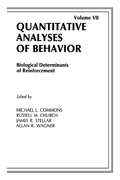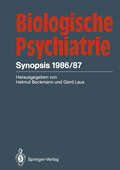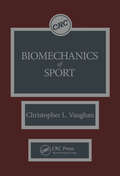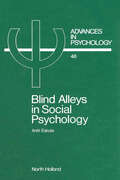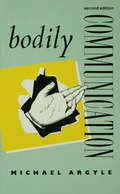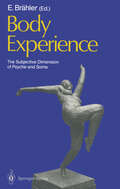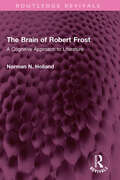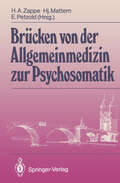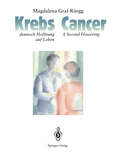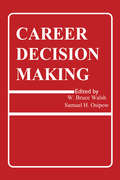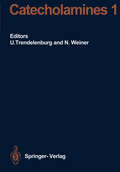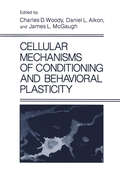- Table View
- List View
Biological Determinants of Reinforcement: Biological Determinates of Reinforcement (Quantitative Analyses of Behavior Series)
by Michael L. Commons Russell M. Church James R. Stellar Allan R. WagnerThis seventh volume, divided into four parts, addresses the biological determinates of reinforcement and memory. Covers topics in electrical brain stimulation, drugs and reinforcement, and cellular mechanisms.
Biologische Psychiatrie: Synopsis 1986/87
Dieser Band enthält die teilweise überarbeiteten Beiträge zum 4. Kongreß der Deutschen Gesellschaft für Biologische Psychiatrie 1986 in Würzburg. Die Beiträge behandeln die Pathomorphologie endogener Psychosen, psychobiologische Modelle affektiver Erkrankungen, operationalisierte Diagnostik, periphere Marker endogener Psychosen, senile Demenz, klinische Themen, neuropsychobiologische Grundlagen, Psychoendokrinologie, apparative Methoden und die Psychopharmakotherapie.
Biomechanics of Sport
by Christopher L. VaughanThis informative text features current and thorough reviews of the biomechanics of sport for improved performance, etiology, and pre-vention of injuries. Winter sports and aquatics are covered, with an emphasis on developing training programs for ski-jumping, alpine, and cross country skiing. Other sports featured include modeling perspectives in speed skating, swimming, and the mechanics of rowing and sculling. Track-and-field athletics, ball games, weight lifting, and training are examined in terms of per-formance, safety, and re-search methodology. Sports scientists and sports medicine specialists will find this book invaluable.
Biomechanics of Sport
by Christopher L. VaughanThis informative text features current and thorough reviews of the biomechanics of sport for improved performance, etiology, and pre-vention of injuries. Winter sports and aquatics are covered, with an emphasis on developing training programs for ski-jumping, alpine, and cross country skiing. Other sports featured include modeling perspectives in speed skating, swimming, and the mechanics of rowing and sculling. Track-and-field athletics, ball games, weight lifting, and training are examined in terms of per-formance, safety, and re-search methodology. Sports scientists and sports medicine specialists will find this book invaluable.
Blind Alleys in Social Psychology: A Search for Ways Out (ISSN #Volume 48)
by A. Eskola A. Kihlström D. Kivinen K. Weckroth O.-H. YlijokiReal advances are not made in blind alleys (or culs-de-sac). In Social Psychology, as in every branch of science, the paths which appear to offer progress do not always result in theoretical elegance. Certain basic problems persistently defy final solution.This volume surveys the foundations and methods of Social Psychology with the aim of identifying ways out of the research maze. It examines the history and traditions of the field, looks at methodology and conceptual schemes, and discusses the actual research methods used.
Bodily Communication
by Michael ArgyleNon-verbal communication - the eye movements, facial expressions, tone of voice, postures and gestures that we all use more or less consciously and more or less effectively - can enhance or diminish every form of social interaction. Michael Argyle's second edition of Bodily Communication is an invaluable up-to-date guide for students of the subject. In the last ten years NVC has become recognized as an important part of social psychology and of professional training, particularly in social work, education and management.Greatly expanded from the first edition, and significantly revised, this second edition has two completely new chapters on social skills and personality, and a new chapter on research methods. The author, a pioneer in the study of non-verbal communication, presents the second edition in the same accessible style as the first, bringing to the reader both his intense interest in the subject and his authoritative knowledge of it.
Bodily Communication
by Michael ArgyleNon-verbal communication - the eye movements, facial expressions, tone of voice, postures and gestures that we all use more or less consciously and more or less effectively - can enhance or diminish every form of social interaction. Michael Argyle's second edition of Bodily Communication is an invaluable up-to-date guide for students of the subject. In the last ten years NVC has become recognized as an important part of social psychology and of professional training, particularly in social work, education and management.Greatly expanded from the first edition, and significantly revised, this second edition has two completely new chapters on social skills and personality, and a new chapter on research methods. The author, a pioneer in the study of non-verbal communication, presents the second edition in the same accessible style as the first, bringing to the reader both his intense interest in the subject and his authoritative knowledge of it.
Body Experience: The Subjective Dimension of Psyche and Soma Contributions to Psychosomatic Medicine
by H. Appelt H. Becker P. Bernhard D. Bongers Elmar Brähler W. Dahlmann H. C. Deter P. Diederichs R. Ernst H. Felder U. Gieler W. Hettich C. Heintze-Hook M. Jarka P. Joraschky M. Lohs P. Möhring H. Müller-Braunschweig A. Otten B. Strauß P. M. WiedemannIn this book body experience is seen as the subjective expression of psyche and soma and is discussed in relation to its significance in modern medical practice and psychoanalysis. The authors relate how the patient's subjective expression of his or her body frequently plays only a marginal role in current therapy and how the central factor of many diseases is consequently missed. Particularly in the growing field of psychoanalytic psychosomatic medicine it will be necessary to pay the issue of body experience more attention. These theoretical and empirical contributions on body experience were specially prepared for the volume. Initial chapters cover a variety of aspects of body experience and its general significance in medicine and psychoanalysis. Following chapters consider body-oriented forms of therapy, sex-related aspects of body experience and the empirical measurement of body experience and bodily complaints.
The Brain of Robert Frost: A Cognitive Approach to Literature (Routledge Revivals)
by Norman N. HollandOriginally published in 1988, this book brings brain science to literary criticism. The Brain of Robert Frost combines psychoanalysis with the findings of brain research and cognitive psychology to model the way we create and respond to literature. Norman Holland draws three central ideas from ‘the mind’s new science’: the critical ‘supercharged’ period in infancy when individuality is formed; the binding of emotion to intellect deep in the old brain; the top-down, inside-out, feedback processing of language in the new. Then, using Robert Frost as an example both of a writer and a reader, and comparing Frost’s reading of a poem to readings by six professors of literature, Holland builds a new, powerful way of thinking about literary criticism and teaching. A book about literary cognition, The Brain of Robert Frost furthers our understanding of the reading process, of poet’s brains, and of our own.
The Brain of Robert Frost: A Cognitive Approach to Literature (Routledge Revivals)
by Norman N. HollandOriginally published in 1988, this book brings brain science to literary criticism. The Brain of Robert Frost combines psychoanalysis with the findings of brain research and cognitive psychology to model the way we create and respond to literature. Norman Holland draws three central ideas from ‘the mind’s new science’: the critical ‘supercharged’ period in infancy when individuality is formed; the binding of emotion to intellect deep in the old brain; the top-down, inside-out, feedback processing of language in the new. Then, using Robert Frost as an example both of a writer and a reader, and comparing Frost’s reading of a poem to readings by six professors of literature, Holland builds a new, powerful way of thinking about literary criticism and teaching. A book about literary cognition, The Brain of Robert Frost furthers our understanding of the reading process, of poet’s brains, and of our own.
Brücken von der Allgemeinmedizin zur Psychosomatik
Dieser Band berichtet von einem 2. arbeitstreffen in Heidelberg, auf dem }ber zentrale Themen der allt{glichen, (haus-){rztlichen Praxis in Vortr{genreferiert, in Arbeitsgruppen debattiert und in Plenumsberichten res}miert wurde. Die frage wart, wie denn psychosomatisches Denken in allgemeinmedizinisches Handeln umzusetzten sei. Wie kann mit Verwicklungen der Arzt-Patient-Beziehung, mit Entt{uschung und Depression (auf beiden Seiten), mit Partnerschafts- problemen oder vertrackten Familienstrukturen, mit ethischen Fragen umgegangen werden? Wie kann der praktisch t{tige Arzt sein verf}gbares R}stzeug therapeutisch optimieren? Dem zumeist seich selbst }berlassenen Arzt soll geholfen werden, (sich) zu helfen.
Career Decision Making (Contemporary Topics in Vocational Psychology Series)
by W. Bruce Walsh and Samuel H. OsipowKeeping up with new developments in vocational psychology is important to both psychological practitioners and researchers. This volume is devoted to presenting and evaluating important advances in the field of career decision making, development, and maturity. More specifically, it identifies, reports, and evaluates significant contemporary developments in vocational psychology and provides both professional workers and students with an informed understanding of the progress taking place in the field. The history and theory of the assessment of career development and decison making are explored as well as advances in career planning systems. An expanded context for the study and evaluation of career development variables is also described.
Career Decision Making (Contemporary Topics in Vocational Psychology Series)
by W. Bruce Walsh Samuel H. OsipowKeeping up with new developments in vocational psychology is important to both psychological practitioners and researchers. This volume is devoted to presenting and evaluating important advances in the field of career decision making, development, and maturity. More specifically, it identifies, reports, and evaluates significant contemporary developments in vocational psychology and provides both professional workers and students with an informed understanding of the progress taking place in the field. The history and theory of the assessment of career development and decison making are explored as well as advances in career planning systems. An expanded context for the study and evaluation of career development variables is also described.
Catecholamines I (Handbook of Experimental Pharmacology #90 / 1)
by H. Bönisch J.P.M. Finberg W. W. Fleming K. H. Graefe S. Z. Langer J. Lehmann H. Matthaei P. B. Molinoff A. Philippu K. F. Tipton U. Trendelenburg D. P. Westfall H. Winkler B. B. Wolfe M.B.H. YoudimCatecholamines are important transmitter substances in the autonomic and central nervous systems. These two volumes provide a comprehensive presentation of the state-of-the-art of catecholamine research and development in the past 15 years. The volumes present in-depth reviews of topical areas of catecholamine research in which substantial progress has been made and which are of current interest to various theoretical and clinical disciplines. Each topic has been dealt with by an established expert. Clinical subjects of relevant importance are included. Catecholamines are of interest in pharmacology, physiology, biochemistry, as well as in neurology, psychiatry, internal medicine (cardiology, hypertension, asthma), ophthalmology and anesthesiology.
Cellular Mechanisms of Conditioning and Behavioral Plasticity
by D. L. Alkon J. L. McGaugh C. D. WoodyI would like first to thank Charles Woody and his organizing committee for arranging the symposium on the "Cellular Mechanisms of Conditioning and Behavioral Plasticity," which was also a satellite meeting of the International Union of Physiological Sciences 30th International Congress. The proceedings of this symposium are represented by the chapters that follow. During the 1970s, Dr. Woody and co-workers were able to carry out a remarkable series of microelectrode studies, both intracellular and extracellular, of cortical nerve cells during conditioning of the eye-blink response to sound in the intact waking cat. He demonstrated enduring changes in excitability and membrane resistance in pericruciate cortical cells during associative conditioning of the eye blink, changes that are facilitated by ACh and cGMP and reinforced by stimulation of the hypothalamus (the latter con firming the original studies of Voronin). These findings have been of considerable im portance in our attempt to understand the conditioning process at the cellular level.
Child Behavior Therapy Casebook
by Michel Hersen Cynthia G. LastSome years ago we edited a general casebook on behavior therapy that was well received. However, those professors who used the book as an adjunct text in child behavior therapy courses were concerned that only 9 of the 26 chapters dealt with the clinical application of behavioral prin ciples to children. Their contention was that a specific casebook on the topic was very much warranted. In considering their comments we took a closer look at the child behavior therapy area and were struck with how diverse it was, how it had expanded, and how it had matured over the last three decades. Given this apparent gap in the literature, we decided to devote an entire casebook to both the standard and the more innovative clinical applications to the behavioral problems presented by children. The resulting book, containing 28 chapters, is divided into two parts. In the first part, in a chapter entitled "How the Field Has Moved On," we briefly trace the historical roots of child behavior therapy, detail the relationship of psychiatric diagnosis and behavioral assessment, and con sider the importance of developmental norms, psychological testing, ef forts at prevention, and behavioral medicine. The bulk of this book, of course, appears in the 27 cases presented by our respective experts. Each of the treatment cases is presented in identical format for pur poses of clarity, consistency, and comparability.
Child Development in a Life-Span Perspective
by E. Mavis Hetherington, Richard M. Lerner, Marion PerlmutterComprised of papers written by members of the Social Science Research Council Subcommittee on Child Development in Life-Span Perspective, this book provides a representation of the current status of the relation between child development and the life- span. It suggests the possible synthesis of these two fields from both conceptual and empirical evidence. Theories and methods concerning the social, psychological, and anatomical influences on children's cognitive development through adolescence are highlighted.
Child Development in a Life-Span Perspective
by E. Mavis Hetherington Richard M. Lerner Marion PerlmutterComprised of papers written by members of the Social Science Research Council Subcommittee on Child Development in Life-Span Perspective, this book provides a representation of the current status of the relation between child development and the life- span. It suggests the possible synthesis of these two fields from both conceptual and empirical evidence. Theories and methods concerning the social, psychological, and anatomical influences on children's cognitive development through adolescence are highlighted.
Children Draw And Tell: An Introduction To The Projective Uses Of Children's Human Figure Drawing
by Marvin Klepsch Laura LogieFirst published in 1988. Routledge is an imprint of Taylor & Francis, an informa company.
Children Draw And Tell: An Introduction To The Projective Uses Of Children's Human Figure Drawing
by Marvin Klepsch Laura LogieFirst published in 1988. Routledge is an imprint of Taylor & Francis, an informa company.
Children In Treatment: A Primer For Beginning Psychotherapists
by Shirley Cooper Leon WanermanFirst published in 1988. Routledge is an imprint of Taylor & Francis, an informa company.
Children In Treatment: A Primer For Beginning Psychotherapists
by Shirley Cooper Leon WanermanFirst published in 1988. Routledge is an imprint of Taylor & Francis, an informa company.
Children’s Counting and Concepts of Number (Springer Series in Cognitive Development)
by Karen C. FusonFor some time now, the study of cognitive development has been far and away the most active discipline within developmental psychology. Although there would be much disagreement as to the exact proportion of papers published in developmental journals that could be considered cognitive, 50% seems like a conservative estimate. Hence, a series of scholary books to be devoted to work in cognitive development is especially appropriate at this time. The Springer Series in Cognitive Development contains two basic types of books, namely, edited collections of original chapters by several authors, and original volumes written by one author or a small group of authors. The flagship for the Springer Series is a serial publication of the "advances" type, carrying the subtitle Progress in Cognitive Development Research. Volumes in the Progress sequence are strongly thematic, in that each is limited to some well-defined domain of cognitive developmental research (e. g. , logical and mathematical development, semantic development). All Progress volumes are edited collections. Editors of such books, upon consultation with the Series Editor, may elect to have their works published either as contributions to the Progress sequence or as separate volumes. All books written by one author or a small group of authors will be published as separate volumes within the series. is being used in the selec A fairly broad definition of cognitive development tion of books for this series.
Clinical Behavioral Medicine: Some Concepts and Procedures
by I.E. WickramasekeraThis book is an effort to integrate some clinical observations, theoretical concepts, and promising clinical procedures that relate psychological variables to physiological variables. My primary emphasis is on what psychological and behavioral concepts and procedures are most likely to enable us to influence physiological functions. The book covers ques tions that have fascinated me and with which I have struggled in daily clinical practice. What types of people are most at risk for physical disor ders or dysfunctions? Why do some people present psychosocial con flicts somatically and others behaviorally? What is the placebo effect and how does it work? How do you arrange the conditions to alter maladap tive belief systems that contribute to psychopathology and patho physiology? Do beliefs have biological consequences? When I was in private clinical practice, and even today in my medi cal school clinical practice situation, I set aside one day each week to puzzle over the theoretical questions that my clinical experience gener ates. Often isolating these underlying theoretical questions provides guidance into the most relevant empirical literature. I have found that this weekly ritual, which I started in private practice many years ago, appears to increase my clinical efficacy or at least makes clinical work more exciting. I find the unexamined clinical practice hard to endure. Kurt Lewin once said, "There is nothing so practical as a good theory.
